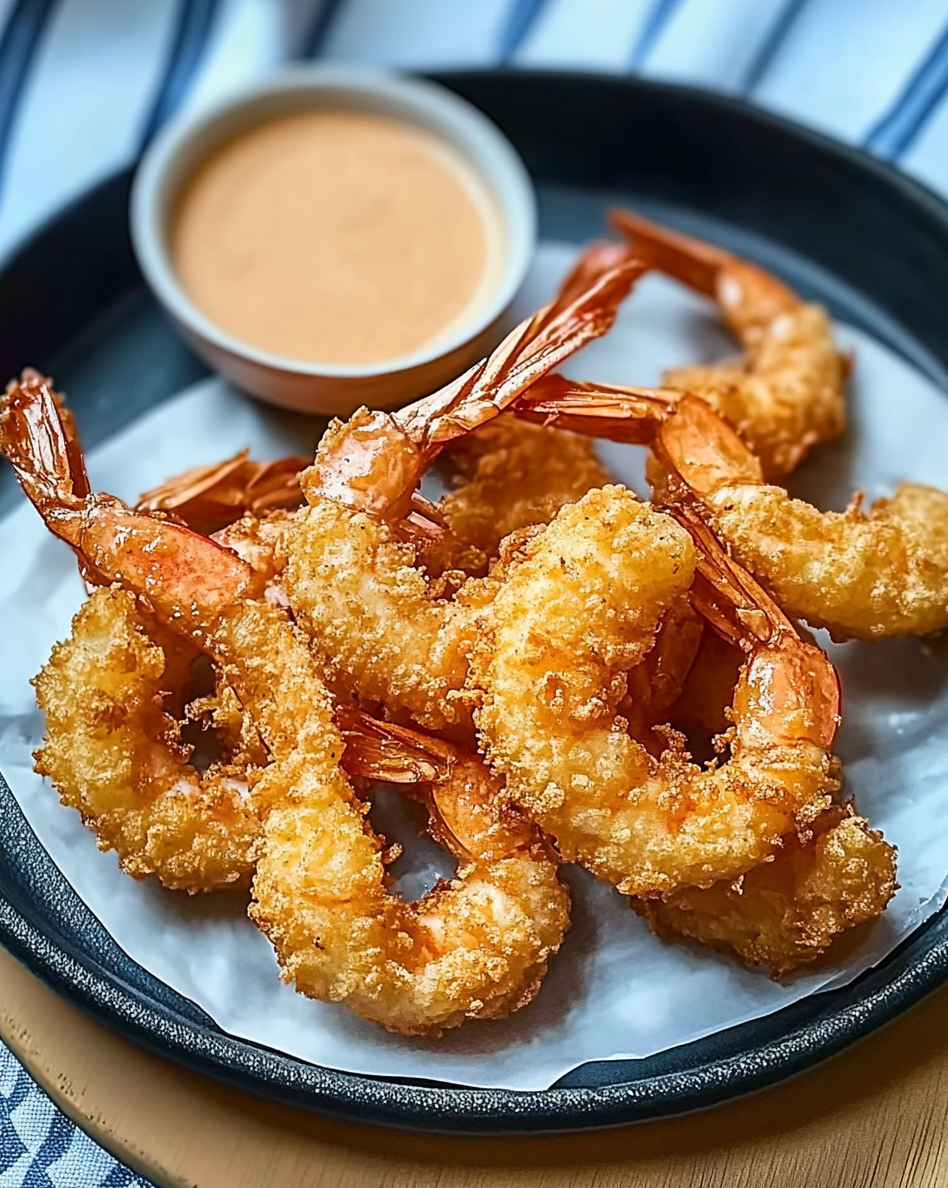The classic Japanese-Style Deep-Fried Shrimp, also known as “Ebi Tempura,” is a beloved dish featuring succulent shrimp coated in a light, crispy batter. This dish is a wonderful blend of textures, with the delicate crunch of the batter giving way to the tender shrimp inside. Served with a wedge of lemon, it’s the perfect appetizer or side dish to elevate any meal.
What makes this dish so special is its simplicity and the use of fresh ingredients. The batter is mixed gently to create a light, airy texture that crisps up beautifully when fried. Whether you are hosting a dinner party or simply craving something crispy and savory, these shrimp are sure to impress. Pair them with a dipping sauce or enjoy them as they are—each bite offers a delightful taste of Japan.
Full Recipe:
- 12 large shrimp, peeled and deveined
- 1 cup all-purpose flour
- 1 egg
- 1 cup ice-cold water
- 1/2 cup cornstarch
- Vegetable oil for frying
- Salt and pepper to taste
- Lemon wedges for garnish
Directions:
- Start by patting the shrimp dry with paper towels. Season with salt and pepper, then set aside.
- In a large bowl, mix the flour and cornstarch together. In a separate bowl, beat the egg lightly and add the ice-cold water, stirring to combine.
- Gradually add the egg mixture to the flour mixture, stirring gently. Be careful not to overmix; the batter should remain slightly lumpy.
- Heat the vegetable oil in a deep fryer or large saucepan to 350°F (175°C).
- Dip the shrimp into the batter, ensuring they are well coated. Carefully place them in the hot oil, frying in batches if necessary to avoid overcrowding.
- Fry the shrimp for 2-3 minutes or until they turn golden brown and crispy. Remove with a slotted spoon and drain on paper towels.
- Serve immediately with lemon wedges on the side.
Prep Time: 10 minutes | Cooking Time: 10 minutes | Total Time: 20 minutes
Kcal: 280 kcal per serving | Servings: 4 servings
Japanese-Style Deep-Fried Shrimp, commonly referred to as “Ebi Tempura,” is a beloved dish in Japanese cuisine. It’s renowned for its delicate, crisp batter and the juicy, tender shrimp encased within. This dish is typically served as an appetizer or side dish but can also be part of a main course, often alongside rice, noodles, or a fresh salad.
Origins and Cultural Significance
Tempura has a rich history in Japanese culinary tradition, dating back to the 16th century. Originally introduced by Portuguese missionaries, the technique of deep-frying seafood and vegetables in a light batter became deeply ingrained in Japanese cooking. Today, tempura is a staple in Japanese restaurants worldwide, often prepared with various ingredients, but shrimp remains one of the most popular choices. Ebi Tempura showcases the Japanese philosophy of highlighting natural flavors and textures, with minimal seasoning to let the freshness of the shrimp shine through.
Cooking Tips and Variations
- Batter Consistency: One of the keys to achieving that signature light and crispy texture is the tempura batter. The batter should be kept cold and slightly lumpy. Overmixing can lead to a dense coating that won’t have the desired delicate crunch.
- Oil Temperature: Maintaining the oil at a consistent temperature (around 350°F or 175°C) is crucial. Too hot, and the batter will burn before the shrimp cooks through. Too cool, and the shrimp will absorb too much oil, resulting in a greasy texture.
- Serving Suggestions: This dish pairs wonderfully with a variety of dipping sauces, such as tentsuyu (a mix of dashi, soy sauce, and mirin) or a simple squeeze of lemon. For a complete meal, serve the shrimp alongside steamed rice, a bowl of miso soup, and a side of pickled vegetables for a balanced, satisfying dining experience.
Nutritional Information
While tempura is fried, it can still be part of a balanced diet. By using fresh shrimp and a light batter, this dish is lower in calories and fat than many other deep-fried foods. A typical serving of Japanese-Style Deep-Fried Shrimp contains around 280 kcal, making it a delightful treat that can fit into various dietary plans when enjoyed in moderation.
Why You’ll Love It
This recipe is quick and straightforward to prepare, making it ideal for both weeknight dinners and special occasions. The contrast between the crispy batter and the succulent shrimp is a sensory delight that appeals to a wide range of palates. Additionally, the batter’s neutral flavor allows you to customize the dish with different seasonings or dipping sauces to suit your preferences. Whether you’re new to Japanese cooking or a seasoned home chef, this dish is a must-try that brings the taste of authentic Japanese cuisine to your table.
Culinary Techniques and Secrets
- Shrimp Preparation: Proper preparation of the shrimp is crucial for this dish. It’s important to devein and peel the shrimp while keeping the tail intact. This not only makes the shrimp easier to handle when frying but also gives the dish an elegant look. Some chefs also make small incisions along the underside of the shrimp to prevent them from curling too much during frying, ensuring a straighter and more aesthetically pleasing presentation.
- The Art of Tempura Batter: Traditional tempura batter is quite simple, consisting mainly of flour, egg, and ice-cold water. The cold water helps to keep the batter light and prevents the flour from absorbing too much oil during frying. For added crispiness, some recipes include a bit of cornstarch or rice flour. Mixing the batter just before frying is key; the goal is to leave it slightly lumpy to create an extra crunchy texture.
- Frying Technique: Japanese cuisine emphasizes the importance of deep-frying as an art. When frying, it’s essential to avoid overcrowding the pan, as this can lower the oil temperature and result in a soggy batter. Fry the shrimp in small batches and watch for the oil’s surface to stay bubbling—this indicates that the temperature is correct and the shrimp are cooking evenly. The shrimp should be golden and crispy in just a few minutes.
- Draining the Excess Oil: After frying, place the shrimp on a wire rack or paper towels to drain excess oil. This step ensures the batter remains crisp and prevents the shrimp from becoming greasy.
Presentation and Serving Ideas
- Classic Presentation: Serve the shrimp on a decorative Japanese-style plate, garnished with a wedge of lemon and a sprinkle of sea salt. Adding a small mound of grated daikon (Japanese radish) on the side with a dipping sauce like tentsuyu (soy sauce, dashi, and mirin) gives it a traditional touch.
- Modern Twist: For a contemporary take, consider serving the shrimp on a bed of mixed greens or alongside a vibrant vegetable tempura assortment. Adding a spicy mayo or wasabi mayo drizzle can offer a fusion of flavors that complement the crispy shrimp.
- Pairing Suggestions: Japanese-Style Deep-Fried Shrimp pairs excellently with steamed jasmine rice or a light soba noodle salad. For beverages, a chilled Japanese beer or sake can enhance the dish’s flavors, while a green tea provides a refreshing non-alcoholic option.
Dietary Adjustments and Customizations
- Gluten-Free Option: To make this dish gluten-free, substitute the all-purpose flour with a gluten-free flour blend and ensure that the cornstarch and other ingredients used are certified gluten-free. Rice flour can also be a great alternative, as it creates an even lighter and crisper batter.
- Lower-Calorie Version: For a lighter version, try baking the shrimp instead of deep-frying them. Arrange the batter-coated shrimp on a baking sheet lined with parchment paper, spray lightly with cooking oil, and bake at 400°F (200°C) for about 12-15 minutes, flipping halfway through. While they won’t have the exact texture of the traditional deep-fried version, they’ll still be delicious and crisp.
- Vegetarian Alternative: If you’re catering to vegetarians, you can use the same batter technique to fry a variety of vegetables like sweet potatoes, zucchini, or mushrooms. Serve these veggie tempuras with the same dipping sauces for an equally delightful dish.
Flavor Enhancements and Variations
- Seasoned Batters: For an added burst of flavor, you can season the batter with a pinch of garlic powder, paprika, or even a dash of chili flakes for some heat. These subtle enhancements won’t overpower the shrimp but will add an intriguing layer to each bite.
- Dipping Sauces: While the classic tempura is often enjoyed with a simple soy-based dipping sauce, you can experiment with others like sweet chili sauce, ponzu sauce, or even a tangy tartar sauce. Each offers a unique flavor profile that can make the dish more versatile.
- Garnishing with Herbs: Adding fresh herbs like chopped cilantro or parsley can provide a refreshing contrast to the fried shrimp. A sprinkle of sesame seeds or a drizzle of spicy mayo over the shrimp can also elevate the dish to restaurant-quality presentation.
Perfect for Different Occasions
- Family Dinners: Japanese-Style Deep-Fried Shrimp is an excellent choice for family dinners. Its quick preparation time and universally loved flavors make it a dish that both kids and adults can enjoy. Serve it alongside rice, miso soup, and a side of stir-fried vegetables for a wholesome meal.
- Entertaining Guests: If you’re hosting a dinner party, these crispy shrimp make a stunning appetizer that can be prepared ahead of time and quickly fried just before serving. Guests will appreciate the effort, and the crispy texture paired with the juicy shrimp will certainly impress.
- Casual Snacking: The shrimp can also serve as a tasty snack for casual gatherings. Serve them as finger food with toothpicks or small skewers, and provide a variety of dipping sauces for guests to enjoy.
Conclusion
Japanese-Style Deep-Fried Shrimp, or “Ebi Tempura,” is a delicious and versatile dish that captures the essence of Japanese cuisine. With its light, crispy batter and tender shrimp, it’s a crowd-pleaser perfect for family dinners, entertaining guests, or casual snacking. Easy to prepare and adaptable to various dietary needs, this recipe offers a delightful way to bring a taste of Japan to your kitchen. Whether you serve it traditionally with dipping sauces or give it a modern twist, it’s a dish that’s sure to impress.






